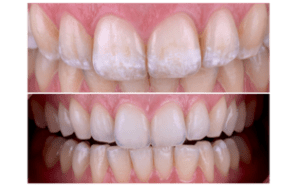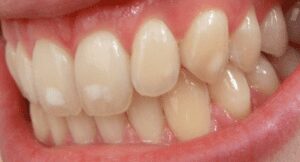 The Revolutionary Solution for White Spots
The Revolutionary Solution for White Spots
Icon Treatment in Chestnut Hill
At The Dental Office at Chestnut Hill, we are dedicated to offering innovative solutions that address a wide range of dental concerns, including the often challenging issue of white spots on teeth. Our Icon treatment is a breakthrough approach that effectively treats these blemishes, offering our patients a smoother, more uniform smile without the need for invasive procedures. As one of the leading dentists in Chestnut Hill, we are proud to provide this advanced dental service to our community.The beginning stage of caries or tooth decay is discoloration, often in the form of white spots on the surface of the tooth. They’re often the result of fluorosis or ineffective brushing habits during orthodontic treatment. Until now, there has been no truly effective treatment option for these cariogenic white spots. Our Icon treatment finally has the solution.
Understanding White Spots on Teeth
White spots on teeth can appear for several reasons and are often a cosmetic concern for many patients. These spots may be the result of fluorosis, which occurs when teeth are exposed to high levels of fluoride during their development. They can also be caused by demineralization, a process where teeth lose minerals due to plaque buildup and acid exposure, which is particularly common among individuals who have had orthodontic treatments. Another less common cause is enamel hypoplasia, a condition that results in thinner enamel and makes the teeth more susceptible to staining and decay.

Treating White Spots: It’s always better to prevent white spots from developing to begin with, but if they do appear, there are a few ways to treat them. Not all stains can be removed with bleaching or microabrasion, but thanks to Icon, there’s no need to jump all the way to veneers.
The Icon Treatment Approach
Icon treatment offers a non-invasive solution to correct these white spots by addressing the imbalance between remineralization and demineralization in the tooth enamel. Here’s how it works:
- Preparation: The affected tooth is cleaned, and microabrasion is used to open up the micro-tubules in the dentin layer. An etching material is then applied to prepare the tooth surface for better bonding.
- Application: A special resin is applied to the tooth while keeping it dry. This resin soaks into the tooth, penetrating the white spot lesions and bonding with the dentin layer.
- Curing: Excess resin is carefully removed, and a special light is used to harden the resin within the tooth, ensuring it is securely in place.
- Polishing: Finally, the tooth is polished to enhance the aesthetic outcome and ensure that the treated area blends seamlessly with the surrounding enamel.
The entire Icon treatment can be completed in about an hour, making it a quick, convenient option for those looking to improve their smile.
Benefits of Icon Treatment
Choosing Icon treatment at The Dental Office at Chestnut Hill provides several advantages over traditional methods of treating white spots:
- Minimally Invasive: Unlike veneers or other invasive treatments, Icon does not require the removal of healthy tooth structure.
- Pain-Free: The procedure is comfortable, with no need for needles or anesthesia.
- Cost-Effective: Icon is more affordable than many alternative cosmetic treatments, such as veneers.
- Quick and Convenient: Treatment is typically completed in just one appointment, with no downtime required.
- Effective: Icon treatment not only improves the appearance of white spots but also strengthens the affected areas, preventing further decay.
- Suitable for All Ages: It is a safe option for both children and adults, making it ideal for those who developed white spots due to orthodontic treatment or fluorosis in childhood.
Why Choose Us for Icon Treatment?
As the dentists in Chestnut Hill that patients rely on for advanced cosmetic solutions, we are committed to delivering exceptional results with every treatment. Our team is extensively trained in the latest dental technologies, ensuring that you receive the highest level of care. We understand the importance of having a smile you can be proud of, and our Icon treatment is just one of the ways we help our patients achieve their dental health and aesthetic goals.
Are You a Candidate for Icon Treatment?
If you are bothered by the appearance of white spots on your teeth and are looking for a non-invasive solution to enhance your smile, Icon treatment might be the perfect option for you. We invite you to visit The Dental Office at Chestnut Hill for a consultation to determine if you are a good candidate for this treatment. Let us help you achieve the flawless smile you’ve always wanted with the help of our expert team and cutting-edge dental care.
At The Dental Office at Chestnut Hill, we are here to ensure that your journey to a perfect smile is smooth, effective, and tailored to your needs. Contact us today to schedule your Icon treatment consultation and take the first step towards the smile you deserve.


